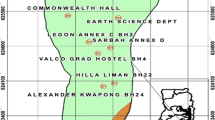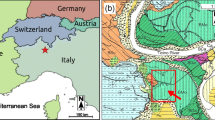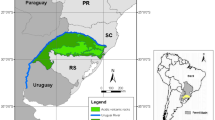Abstract
A transient finite difference groundwater flow model has been calibrated for the Nasia sub-catchment of the White Volta Basin. This model has been validated through a stochastic parameter randomization process and used to evaluate the impacts of groundwater abstraction scenarios on resource sustainability in the basin. A total of 1500 equally likely model realizations of the same terrain based on 1500 equally likely combinations of the data of the key aquifer input parameters were calibrated and used for the scenario analysis. This was done to evaluate model non-uniqueness arising from uncertainties in the key aquifer parameters especially hydraulic conductivity and recharge by comparing the realizations and statistically determining the degree to which they differ from each other. Parameter standard deviations, computed from the calibrated data of the key parameters of hydraulic conductivity and recharge, were used as a yardstick for evaluating model non-uniqueness. All model realizations suggest horizontal hydraulic conductivity estimates in the range of 0.03–78.4 m/day, although over 70 % of the area has values in the range of 0.03–14 m/day. Low standard deviations of the horizontal hydraulic conductivity estimates from the 1500 solutions suggest that this range adequately reflects the properties of the material in the terrain. Lateral groundwater inflows and outflows appear to constitute significant components of the groundwater budgets in the terrain, although estimated direct vertical recharge from precipitation amounts to about 7 % of annual precipitation. High potential for groundwater development has been suggested in the simulations, corroborating earlier estimates of groundwater recharge. Simulation of groundwater abstraction scenarios suggests that the domain can sustain abstraction rates of up to 200 % of the current estimated abstraction rates of 12,960 m3/day under the current recharge rates. Decreasing groundwater recharge by 10 % over a 20-year period will not significantly alter the results of this abstraction scenario. However, increasing abstraction rates by 300 % over the period with decreasing recharge by 10 % will lead to drastic drawdowns in the hydraulic head over the entire terrain by up to 6 m and could cause reversals of flow in most parts of the terrain.












Similar content being viewed by others
References
Acar Ӧ et al (2013) A stochastic model for estimation groundwater and contaminant discharges from fractured rock passive flux meter measurements. Water Resour Res 49:1–15
Addai OM et al (2015) Groundwater recharge processes in the Nasia sub-catchment of the White Volta Basin: analysis of porewater characteristics in the unsaturated zone. J Afr Earth Sci. doi:10.1016/j.jafrearsci.2015.04.006
Adu SV (1995) Soils of the Nasia river basin northern region of Ghana. Soil research Institute (Council for Scientific and Industrial Research), Academy Post Office, Kwadaso-Kumasi, Ghana
Aquaveo (2014) GMS 10.0 tutorial: MODFLOW—stochastic modeling, parameter randomization. Aquaveo, Provo, Utah
Amisigo BA et al (2015) Modeling impact of climate change on water resources and agriculture demand in the Volta Basin and other basin systems in Ghana. Sustainability 7:6957–6975
Anderson MP, Woessner WW (1992) Applied groundwater modeling. Academic Press, San Diego, CA, USA
Anderson MP, Woessner WW (2002) Applied groundwater modeling. Academic Press, San Diego, CA, USA
Attandoh N et al (2013) Conceptualization of the hydrogeological system of some sedimentary aquifers in Savelugu–Nanton and surrounding areas, Northern Ghana. Hydrol Process 27:1664–1676. doi:10.1002/hyp.9308
Awotwi A et al (2015) Predicting hydrological response to climate change in the White Volta Catchment, West Africa. Earth Sci Clim Chang 6:1–7
Baalousha H, Kӧngeter J (2006) Stochastic modelling and risk analysis of groundwater pollution using FORM coupled with automatic differentiation. Adv Water Resour 29:1815–1832
Boronina A et al (2003) Groundwater resources in the Kouris catchment (Cyprus): data analysis and numerical modeling. J Hydrol 271:130–149
Bozhko, N.A., (1973). Upper Precambrian intracratonic folded zones and a cover of basins. In: Katz J, Vysotsky IV, Khain VE (eds) Geology and mineral resources of Africa “Nedra,” 227–276 (in Russian)
Brammer H (1967) Soils of the Accra Plains. Soil Research Institute. C.S. I. R. Memoir No. 3, Ghana
Dapaah-Siakwan S, Gyau-Boakye P (2000) Hydrological framework and borehole yields in Ghana. Hydrogeol J 8:405–416
Dickson, K.A., and Benneh, G., 1995. A new geography of Ghana. Revised Edition, 2nd Edition. Longman Group UK Ltd. p. 17–29
Ghana Statistical Services GSS (2012) 2010 population and housing census: summary report of the final results. Ghana Statistical Services, Accra, Ghana
Harbaugh, A.W., et al. (2000) MODFLOW-2000, the U.S. Geological Survey modular ground-water model, Open File Rep. 00-92. U.S. Geol. Surv
Hu L et al (2011) Simulation of groundwater flow within observation boreholes for confined aquifers. J Hydrol 398:101–108
Khan S et al (2008) Hydrogeologic assessment of escalating groundwater exploitation in the Indus Basin, Pakistan. Hydrogeol J 16:1635–1654
Kranjac-Berisavljevic G (1999) Recent climatic trends in northern interior savannah zone of Ghana; implication for agricultural production. A paper presented at the International Conference on Integrated Drought Management, 20–22 September 1999, Pretoria South Africa
Kunstmann H, Jung G (2005) Impacts of regional climate change on water availability in the Volta basin of West Africa. Regional Hydrological Impacts of Climatic Variability’ Proceedings of symposium S6 held during the Seventh IAHS Scientific Assembly IAHS Publ 295:1–11
Lambert PM (1995) Numerical simulation of ground-water flow in basin-fill material in Salt Lake Valley, Utah. Utah Department of Natural Resources Technical Publication 110-B, 58 p
Li S-G et al (2003) A computationally practical method for stochastic groundwater modelling. Adv Water Resour 26:1137–1148
Qi W et al (2016) Quantifying dynamic sensitivity of optimization algorithm parameters to improve hydrological model calibration. J Hydrol 533:213–223
Sreekanth J et al (2016) Pareto-based efficient stochastic simulation-optimization for robust and reliable groundwater management. J Hydrol 533:180–190
Tonkin M, Doherty J (2009) Calibration-constrained Monte Carlo analysis of highly parameterized models using subspace techniques. Water Resour Res 45(12)
Wondzell et al (2009) Evaluation of alternative groundwater flow models for simulating hyporheic exchange in a small mountain stream. J Hydrol 364:142–151
Yidana SM (2011) Groundwater flow modeling and particle tracking for chemical transport in the southern Voltaian, aquifers, Ghana. J Environ Earth Sci 63(4):709–721. doi:10.1007/s12665-010-0740-y
Yidana SM et al. (2010) Wetlands in Northern Salt Lake Valley, Salt Lake County, Utah—an evaluation of the threats posed by ground-water development and drought. A Report on investigation 268, Utah Geological Survey, Salt Lake City Utah
Yidana SM, Koffie E (2014) The groundwater recharge regime of some slightly metamorphosed Neoproterozoic sedimentary rocks: an application of natural environmental tracers. Hydrol Process. doi:10.1002/hyp.9859
Yidana SM et al (2014) Simulation of groundwater flow in a crystalline rock aquifer system in Southern Ghana—an evaluation of the effects of increased groundwater abstraction on the aquifers using a transient groundwater flow model. Hydrol Process 28:1084–1094
Yidana, SM et al (2015).Estimation of evapotranspiration losses in the vadose zone using stable isotopes and chloride mass balance method. Environ. Earth Sci 75(3):1–18
Zhang Q et al (2004) Numerical investigation of seawater intrusion at the Gooburrum, Bundaberg, Queensland, Australia. Hydrogeol J 12:674–687
Author information
Authors and Affiliations
Corresponding author
Rights and permissions
About this article
Cite this article
Yidana, S.M., Addai, M.O., Asiedu, D.K. et al. Stochastic groundwater modeling of a sedimentary aquifer: evaluation of the impacts of abstraction scenarios under conditions of reduced recharge. Arab J Geosci 9, 684 (2016). https://doi.org/10.1007/s12517-016-2718-x
Received:
Accepted:
Published:
DOI: https://doi.org/10.1007/s12517-016-2718-x




